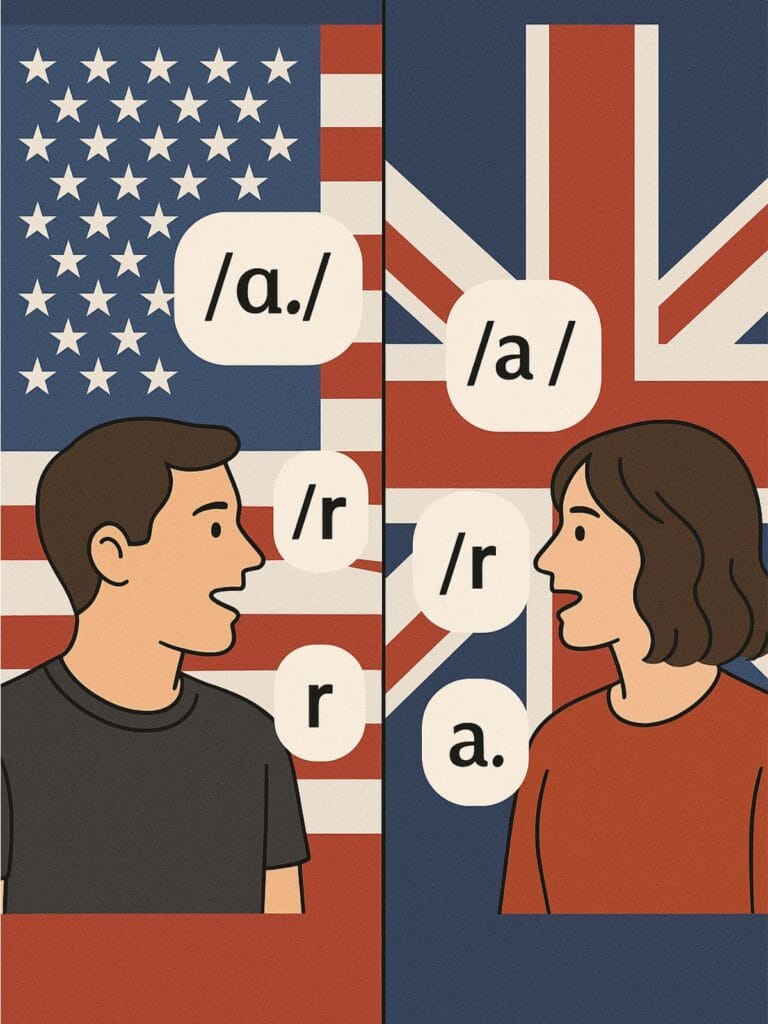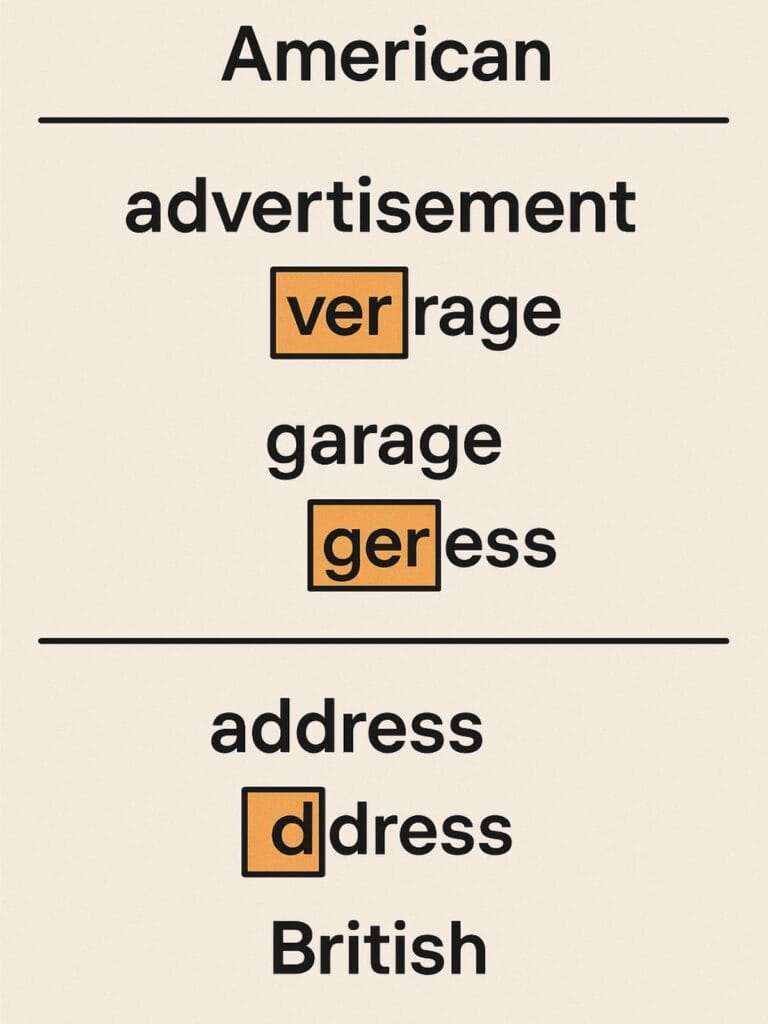Introduction
Have you ever noticed that the same word can sound completely different if you’re talking to an American or a Brit? For example, an American might say “schedule”/sked-jool/, whereas a Brit might use the example “schedule”/shed-yool/. In actuality, these are not merely accents, but profound differences in sound and pronunciation patterns.
As an English learner, teacher, voice-over artist, content creator, or someone preparing for these types of international communications, or exams such as IELTS, TOEFL, or Cambridge English, it becomes paramount to know the differences in pronunciation between American and British English. There may be instances that you want to sound like a native. However, in many cases, you may just want to make sure you are understood clearly. These are all points to consider if you’re using English as a second language. We will explain some differences between different styles of pronunciation to make it easier to practice articulating words with these slight variations, and help you with the right pronunciation to improve your English fluency.

Why Do American and British English Sound So Different?
The evolution of the English language and in pronunciation following the colonization of North America led to natural and untraceable shifts in terms of pronunciation. British English kept many of the older patterns of speech whereas American English adopted the influences of the new immigrants associated with each colonial region and regional ease, consistency, and, phonetic spellings of the words. The system that had been shared over time became different.
In particular, there are four main differences that play a large role in pronunciation, including:
- vowel sounds
- consonant sounds
- word stress and intonation
- rhoticity (the way the “r” is pronounced)
We will take a look at these items in more detail along with some examples and things that we can do.
Vowel Sound Differences
Vowels are one of the most easily identifiable distinctions in American and British accents. All it takes is one little word and the vowel can completely alter the sound.
| Word | American English | British English |
| Dance | dæns/ (dæns) | /dɑːns/ (dahns) |
| Bath | /bæθ/ (bath) | /bɑːθ/ (bahth) |
| Hot | /hɑːt/ (haht) | /hɒt/ (hot) |
| Tomato | təˈmeɪtoʊ | təˈmɑːtəʊ |
| Garage | gəˈrɑːʒ | ɡærɑːʒ |
American English typically uses a flat or nasal /æ/ vowel (as in “cat”), whereas British English sometimes uses rounded vowels. In broad terms, for the word “bath,” Americans use /bæθ/ which is the short “a,” to Britishers use /bɑːθ/ (the a is longer and deeper). The diphthong, or two vowel sounds in one syllable, also varies. “Go” might sound like /goʊ/ in American English, but might sound like /gəʊ/ in British English.
How to Practice
Use tools like Forvo or YouGlish to hear native speakers pronouncing the words in both accents. Record yourself saying the same words and compare and adjust as needed.
Consonant Sound Differences
While consonants may seem stable across dialects, there are essential pronunciation differences that could make or break your fluency.
The “R” Sound (Rhoticity)
The rhotic “R” sound is a major distinguishing feature of American English, where people pronounce the “R” sound strongly, especially at the ends of words.
- American: “Car” = /kɑːr/
- British: “Car” = /kɑː/
Most British dialects, particular Received Pronunciation (RP) are non-rhotic which means they do not pronounce the “R” unless it is followed by a vowel sound.
Another example:
- American: “Hard” = /hɑːrd/
- British: “Hard” = /hɑːd/

The Flapped “T”
Americans use the flap T often, which sounds more like a soft “d” sound. The British speakers stick to a crisp “t” sound.
| Words | American English | British English |
| Water | WAH-der | WAH-ter |
| Better | BEH-der | BET-ter |
| City | SIH-dee | SIT-ee |
This often confuses learners expecting a hard “t” in American English who don’t realize that the difference is purely phonetic.
The “L” Sound
L” pronunciation can vary at the end of words across the accents as well. Americans, commonly, have what is called a darker L (the back of the tongue is raised), British stick to a lighter L (more fronted in the mouth) often.
- American: “Feel” has a very deep “L” sound
- British: “Feel” has a lighter, more fronted “L”
Word Stress and Intonation
In addition to the individual sounds, word stress and intonation also separate American and British pronunciation. Word stress refers to what syllable gets the emphasis relative to rest of the word when saying the word.
British English tends to stress the first syllable in many multi-syllable nouns, while American English typically shifts stress to the second syllable in the same words or phrases.

Common Stress Differences
| Words | American Stress | British Stress |
| Advertisement | ad-ver-TISE-ment | AD-ver-tise-ment |
| Address | ad-DRESS | AD-dress |
| Garage | guh-RAZH | GAR-ij |
| Adult | a-DULT | AD-ult |
| Research | re-SEARCH | RE-search |
In addition, British English has a more pronounced intonation pattern, while American English is more even or neutral in pitch.
British English typically has stress on the first syllable of some multi-syllable nouns while American English puts the stress on the second syllable.
In addition, British English uses a much more varied intonation pattern, while American English uses a less varied, or more neutral, intonation pattern.
Real-Life Vocabulary Examples
To further highlight the differences, here are some common words that are pronounced differently.
| Words | American Pronunciation | British Pronunciation |
| Schedule | /ˈskɛdʒ.uːl/ (sked-jool) | /ˈʃɛd.juːl/ (shed-yool) |
| Route | /ruːt/ or /raʊt/ | /ruːt/ |
| Mobile | /ˈmoʊ.bəl/ | /ˈməʊ.baɪl/ |
| Either | /ˈiː.ðər/ or /ˈaɪ.ðər/ | /ˈaɪ.ðə/ |
| Vitamin | /ˈvaɪ.tə.mɪn/ | /ˈvɪ.tə.mɪn/ |
The variations can be very important in a professional or academic environment where you need to be clear and consistent.
Split-screen: American speaker and British speaker with speech bubbles showing “schedule” (sked-jool vs. shed-yool).
Regional Variations Within the Accents
Both British and American English have regional dialects which further affect pronunciation.
For example:
- In Southern American English, “pen” can sound like “pin.”
- In Scouse (Liverpool), it may sound more like “buck” instead of “book.”
- In New York English, the “r” is often dropped in certain environments, and resembles the non-rhoticity in Britain.
It is important to be aware of these regional features, especially for understanding and not being confused.
How to Choose Which Accent to Learn
Choosing between American or British pronunciation will likely depend on your goals, where you live, and what you’ve been exposed to.
Here are some things to think about:
- Location: Do you live, work, or plan to move, to a country that uses one version?
- Exams: IELTS tests are based on British English while TOEFL tests work more on American English.
- Listening Trends: Do you watch mostly American shows or listen to mostly American podcasts? If so, following and mimicking the American accent may be easier for you.
- Professional Environment: Do your clients have more contacts/responsibilities in the US or UK? Then it makes sense to use their speech patterns to improve communication.
Practical Tips for Practicing American vs. British Pronunciation
A few ideas on what to do, regardless of which pronunciation you choose.
1. Shadowing Technique
- Select an audio or video clip from a native speaker.
- Repeat every sentence in your target language, immediately after hearing it.
- You should ideally be mimicking the intonation, stress and rhythm.
2. Use Accent-specific Resources
For British English use:
- BBC Learning English
- Oxford Learner’s Dictionaries (audio)
For American English use:
- Rachel’s English YouTube channel
- Merriam-Webster Dictionary (audio feature)
3. Record Your Speech
Utilize the voice memo app on your phone to record your own speech. After, a good practice would be to compare it with native samples. This will help highlight certain sounds or sound stress patterns that you may want to adjust.
4. Practice with Minimal Pairs
Minimal pairs are words that differ by only a single sound, which changes the meaning.
Examples:
- ship / sheep
- cot / caught
- bat / bet
Practicing with minimal pairs helps you refine your ear to slight pronunciation shifts.
5. Use skill-development Apps
Nowadays, there are many apps which come with speech recognition and pronunciation adjustment.
Some recommended apps include:
- ELSA Speak (AI Feedback)
- Speechling
- FluentU (videos, subtitles, quizzes)
Frequently Asked Questions
Q: Is British English “more correct” than American English?
A: Neither one is more correct—British English and American English are different dialects of the same language, and both varieties have standardization and acceptance depending on region or situation.
Q: Is it ok to mix accents when you are speaking English?
A: Mixed accents are fine, especially as a learner, but it is best to stick with one pronunciation style for correctness and consistency.
Q: Will Americans be confused if I use British pronunciation when I am speaking in the USA?
A: Most Americans will understand British English, even if some words sound funny to them. At worst, you will have to repeat a word to clarify.
Final Thoughts
Knowing the differences between American and British pronunciation is not just about the accent; it is about clarity, cultural context, and feeling comfortable to speak. You may want to imitate or copy one style more than the other, or you may just want to recognize one style or the other, but being aware of pronunciation will allow you to communicate in English much more effectively!
As a final thought, think of pronunciation as not only about sounding perfect, it is about the listener understanding you clearly and you feeling confident when you speak. You can do it! With regular practice and good resources, you can master and use either accent!
Related Topics
- Best Top Online Courses That Can Help You Learn English Faster In 2025
- How to Learn English Faster: 7 Proven Strategies For Success
Try this App Vista Social


